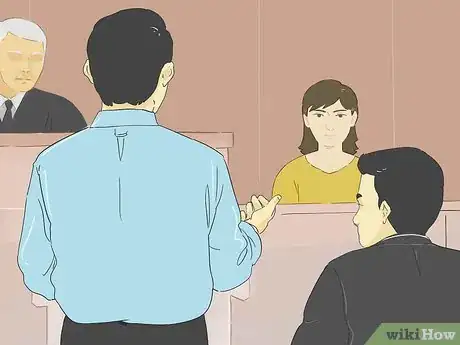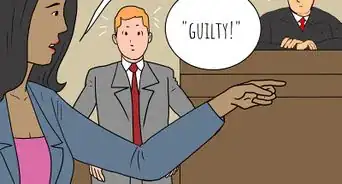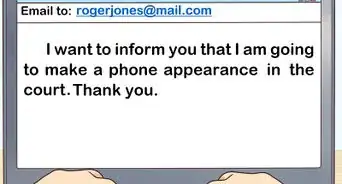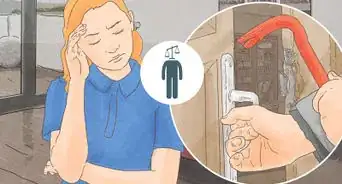This article was written by Jennifer Mueller, JD. Jennifer Mueller is an in-house legal expert at wikiHow. Jennifer reviews, fact-checks, and evaluates wikiHow's legal content to ensure thoroughness and accuracy. She received her JD from Indiana University Maurer School of Law in 2006.
There are 8 references cited in this article, which can be found at the bottom of the page.
This article has been viewed 61,343 times.
Any proceeding in family court is stressful and emotional for all participants. In the heat of the moment, it's possible that someone might feel cornered and lie on the stand in an attempt to secure what they believe is best for their family or their children. People can also lie for more malicious reasons. By far the strongest way to prove someone is lying in family court is to present concrete evidence that conflicts with their story. However, in family court cases, this kind of evidence isn't always available. If you don't have evidence, you can cross-examine them to attempt to cast doubt on their story or, as a last resort, testify against them yourself.[1]
Steps
Presenting Conflicting Evidence
-
1Use messages directly from the witness. Anything the witness said or wrote themselves, including text messages, social media posts, and voicemails, are generally admissible in family court. If they said something in such a message that directly contradicts what they said on the stand, you can use that evidence to prove that they're lying.[2]
- For example, if you have testified that the witness called you insulting names and the witness denies it, you might produce text messages in which the witness called you the same or similar names.
- If the messages use a screen name or user name that differs from the witness's real name, provide additional information, such as posted selfies, to establish that the account belongs to the witness and that they wrote the messages.
-
2Introduce documents to prove that what the witness said was wrong. If the witness lies about something factual, you might be able to find documents that show those facts to be different from what the witness claimed them to be. As long as these are official documents, they can generally be admitted in family court.
- For example, if a defendant spouse lies about their income, you could introduce check stubs or tax returns that show the amount of money they actually make.
Tip: Keep in mind that this doesn't necessarily prove that the witness was lying — they can later claim that they simply recalled the information incorrectly. However, it does prove that the information they conveyed to the court was wrong.
Advertisement -
3Provide photographs that show damage done by the witness. Lying in family court is perhaps most prevalent when you allege acts of domestic violence. The person you accuse of domestic violence will almost always deny that they did the things you claim they did. Photographs can help you prove the damage done by the person, making your case stronger than their denial.[3]
- For example, if you stated in your written complaint that the witness had destroyed your clothing, but they denied it, you could present a photo that showed your destroyed clothing. While the photo wouldn't necessarily prove that the witness destroyed your clothing, it could be persuasive along with other information, such as the fact that they were the only person in the house at the time.
Cross-Examining the Witness
-
1Talk to an attorney if you have a contentious family law case. Most family law attorneys provide a free initial consultation, which can at least help you decide if you need to hire an attorney to represent you in court. However, if you have a strong suspicion that the other party or another witness is going to lie in court, or if the other party has already lied in court papers, this is not a situation you want to face alone.[4]
- If you have an attorney representing you, they'll be in charge of cross-examining the witness. This can help you catch the witness in a lie because your attorney has the training and experience to know exactly what to ask the witness and how to get to the truth.
- If you don't hire an attorney, on the other hand, you'll have to cross-examine witnesses on your own. This can be difficult under any circumstances if you don't have any legal training, but it's even more of a challenge if emotions are running high, as they often are in family court cases.
-
2Use cross-examination to poke holes in the witness's account. When a witness takes the stand and testifies for the other side in any lawsuit, you (or your attorney) have the opportunity to cross-examine them. If you believe they were lying, you can use cross-examination to catch them in the lie.[5]
- For example, if a witness claimed that someone else had destroyed property you claim they destroyed, you might ask them who else was in the house on the day the property was destroyed. If no one else was there, it seems obvious that they destroyed the property, then tried to deny it.
- Incorporate the language of deception into your questions to help persuade the judge that the witness's account shouldn't be trusted.
- For example, if the witness lied about their income on a financial disclosure statement for a divorce, you might ask "Is it true that you make an additional $2,000 a month that you fraudulently omitted from your disclosure statement?" The word "fraudulently" makes the question more persuasive regardless of the witness's answer.
-
3Ask the witness leading questions about the thing they lied about. Leading questions are considered the hallmark of cross-examination. By leading the witness towards a specific answer, you can catch them in a lie they made during direct examination.[6]
- For example, suppose you've accused the witness of domestic violence, a fact they deny. You might start a line of questioning like this: "Isn't it true that you believe yourself to be the master of your home? And if someone defies your orders, you get angry, do you not? When you get angry, do you tend to get physical? Isn't it true that you once punched a hole in the wall?"
Tip: If your attorney is conducting the cross-examination, they'll already know this rule. However, if you're cross-examining a witness on your own, remember never to ask a question that you don't already know the answer to. They may continue to lie, but you can get your own case in trouble if you ask them an open-ended question and don't know how they're going to respond.
-
4Bring up contradictory statements the witness said in a deposition. The most common way to prove a witness's testimony is false is through a deposition, which is an interview under oath, usually conducted by attorneys. Depositions are rare in family court proceedings. However, if the witness was deposed, and said something that contradicts a false statement they made on the stand, you can bring it up during cross-examination.[7]
- Start by introducing the deposition and asking the witness if they recall attending the deposition and the things they said there. Then, ask if they said the contradictory statement. They will likely say they don't remember. You can then introduce the statement in the deposition transcript as evidence.
- For example, suppose a witness claims that they were never angered by their husband. You might ask "Isn't it true that in your deposition on December 19, you said that your husband frequently angered you and caused you to lash out?" If they said they didn't remember, you could introduce the statement.
-
5Use past convictions for dishonesty to question the witness's credibility. In some situations, if a witness has a previous criminal conviction for fraud, perjury, or another crime directly involving dishonest conduct, you can use that conviction to show that they are not an honest or reliable witness. Often, you need prior permission from the judge before you can take this step.[8]
- In some courts, you can also use recent felony convictions of any type of crime. However, the conviction typically has to be within the past 10 years at the latest.
- Be careful using past convictions to bring the witness's credibility into question. This can often result in a back-and-forth with the two of you simply trying to destroy each other's reputation, with little gain.
Warning: Use of past convictions is subject to state and local court rules and varies widely among jurisdictions. This may not be permitted in your family court.
Providing Testimony
-
1Call an eyewitness to the stand. If the witness lies about the way something happened and there was someone else there, you can subpoena that person to tell the court what really happened. Make sure any eyewitness you call had a clear understanding of what was happening and is able to recall specific details on the stand.[9]
- Eyewitnesses can get tricky in family court, especially if your eyewitness is a relative. You may end up having to prove that the eyewitness isn't simply lying for your benefit.
- Someone who seems more closely aligned with the lying witness is often a better eyewitness than someone who seems more closely aligned with you. For example, if you've filed for divorce and your wife lied on the stand about a fight the two of you had, calling her sister as an eyewitness would be better than calling your own sister.
- Only call eyewitnesses who directly witnessed the event or the behavior. If the disputed incident involves texting, online interactions, or a phone call, it's fine if they only witnessed one side of the incident as long as they were actually there.
Tip: If the witness is lying about social media posts or messages that they've since deleted, you might call a mutual friend as an eyewitness to confirm to the court that the posts or messages were there.
-
2Take the stand yourself and tell your side of the story. In family court, many issues come down to one side's word against the other's. Often, the only way you can prove someone is lying is to tell the court what really happened from your perspective and hope your account is more credible.[10]
- When you tell your side of the story, stick to the facts and avoid expressing your opinion or making assumptions about why another person might have said or done something.
- If you have an attorney, they'll likely rehearse your testimony with you. However, you don't want to practice too much. You want your testimony to sound natural, not coached or prepared. This will make it seem like your attorney told you what to say.
- When you testify, the other side also has the right to ask you questions. They will try to make you seem like you aren't honest or credible. Do your best to remain calm and keep a level head. Answer the questions directly, but don't supply any additional information they didn't ask for.
-
3Use an expert witness to call the witness's testimony into doubt. In some situations, an expert witness can help shed light on the situation and make a witness's lies more apparent to the judge. Expert witnesses in family court cases might include psychologists, school counselors, teachers, or social workers.[11]
- For example, if a witness lied and stated they never abused their children, you might call a school counselor, teacher, or social worker who could testify that they saw bruises on the child or that the child told them about the abuse.
Warnings
- This article is based on family court procedures in US courts. If you live in another country, different rules might apply. Consult a local attorney who specializes in family law for more information.⧼thumbs_response⧽
- No matter how completely you expose the lie, never call the witness a liar in court. This is considered improper and can even result in your case being dismissed or reversed on appeal.[13]⧼thumbs_response⧽
References
- ↑ https://www.hg.org/legal-articles/what-can-i-do-if-someone-is-lying-to-the-court-36990
- ↑ https://www.seols.org/wp-content/uploads/2018/02/How-to-Present-Evidence-in-Court.pdf
- ↑ https://www.seols.org/wp-content/uploads/2018/02/How-to-Present-Evidence-in-Court.pdf
- ↑ https://www.americanbar.org/groups/family_law/resources/faqs/
- ↑ https://www.gairgair.com/docs/7_14_2017_exposing_a_lie.pdf
- ↑ https://www.gairgair.com/docs/7_14_2017_exposing_a_lie.pdf
- ↑ https://www.law.indiana.edu/instruction/tanford/b723/10impeach/T10.pdf
- ↑ https://www.law.indiana.edu/instruction/tanford/b723/10impeach/T10.pdf
- ↑ https://www.justice.gov.nt.ca/en/files/victim-services/Being%20a%20Witness.pdf







































































